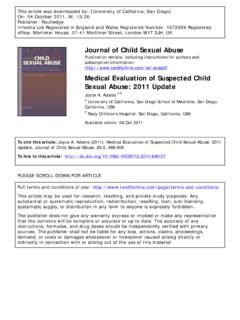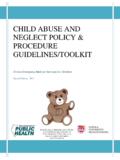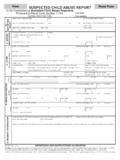Transcription of Making and Screening Reports of Child Abuse and …
1 Children s Bureau/ACYF/ | Email: | STATUTESC urrent Through January 2017 WHAT S INSIDEC ontent of reportsReporting suspicious deathsReporting substance-exposed infantsAgency receiving the reportsInitial Screening decisionsAgency conducting the assessment/investigationAssessment/inves tigation proceduresTimeframes for completing investigationsClassification of reportsSummaries of state lawsTo find statute information for a particular state, go to and Screening Reports of Child Abuse and Neglect All 50 states, the District of Columbia, American Samoa, Guam, the Northern Mariana Islands, Puerto Rico, and the Virgin Islands have laws and policies that specify procedures for Making and responding to Reports of suspected Child Abuse or neglect. These laws require certain professionals, known as mandated reporters, to make an immediate report when they suspect or know of abusive or neglectful situations.
2 (For more information about the requirements for these individuals to report , see Child welfare Information Gateway s Mandatory Reporters of Child Abuse and Neglect at ) State laws and policies also specify the required content of Reports , criteria for Screening Reports , investigation procedures, timeframes for completing investigations, and classification of investigative findings. Many states also have special procedures for handling Child fatalities and substance-exposed unT hogJJnent aJy2g01 27 pse:T unT cJt:Jo0 2 This material may be freely reproduced and distributed. However, when doing so, please credit Child welfare Information Gateway. This publication is available online at of ReportsOral Reports can be made to Child protective services (CPS), a local law enforcement agency, or a statewide Child Abuse hotline. In 18 states, American Samoa, Guam, and Puerto Rico, a mandated reporter is required to submit a written report after he or she has made an oral In nine states, the District of Columbia, and the Virgin Islands, a written report is required only when requested by the department or agency that received the initial states specify in statute the types of information that should be included in a report of suspected Abuse or neglect.
3 The reporter will be asked to provide as much information about the Child s situation as he or she can, including the names and addresses of the Child and the Child s parents or other persons responsible for the Child s care, the Child s age, conditions in the Child s home environment, the nature and extent of the Child s injuries, and information about other children in the same Suspicious DeathsApproximately 34 states, American Samoa, Guam, the Northern Mariana Islands, and Puerto Rico provide for specific reporting procedures to be followed when the reporter suspects that Child Abuse or neglect may have caused the death of a Typically, the statutes instruct a mandatory reporter to report a suspicious Child death to a medical examiner or coroner. For states that do not have specific reporting procedures for suspicious Child deaths, standard Child Abuse reporting procedures Alabama, California, Colorado, Connecticut, Hawaii, Illinois, Iowa, Louisiana, Maryland, Massachusetts, Michigan, Minnesota, Mississippi, Nebraska, Nevada, New York, Pennsylvania, and Rhode Georgia, Kansas, Kentucky, Maine, New Hampshire, North Dakota, Ohio, Washington, and West The word approximately is used to stress the fact that states frequently amend their laws.
4 This information is current through January 2017. The 34 states that provide procedures for reporting suspicious Child deaths are Arkansas, California, Colorado, Connecticut, Delaware, Florida, Illinois, Indiana, Kansas, Louisiana, Maine, Massachusetts, Michigan, Minnesota, Mississippi, Missouri, Montana, Nevada, New York, North Carolina, Ohio, Oregon, Pennsylvania, Rhode Island, South Carolina, South Dakota, Tennessee, Texas, Utah, Virginia, Washington, West Virginia, Wisconsin, and Substance-Exposed InfantsMothers who use drugs or alcohol during their pregnancy may give birth to infants who show signs or symptoms of drug exposure. The federal Child Abuse Prevention and Treatment Act (CAPTA) requires states to have policies and procedures to address the needs of substance-exposed Approximately 24 states and the District of Columbia have specific reporting procedures for cases of suspected substance-exposed In general, these statutes make drug exposure or a positive drug test alone the basis for reporting Child Abuse or neglect.
5 Standard reporting procedures apply in those states that statutorily define infant drug exposure as Child Abuse and neglect but have no specific reporting procedures for substance-exposed Agency Receiving the ReportsIn all jurisdictions, the initial report may be made to either CPS or a law enforcement agency. Laws in 34 states, the District of Columbia, Guam, and Puerto Rico require state agencies to maintain centralized telephone lines 24 hours a day, 7 days a week, for the acceptance of Child maltreatment In practice, most states have statewide, toll-free numbers for accepting Reports of maltreatment. In some states, Reports may be made via the 4 42 5106a(b)(2)(B)(iii) (2010).5 Alaska, Arizona, Arkansas, California, Illinois, Iowa, Kansas, Kentucky, Louisiana, Maine, Maryland, Massachusetts, Michigan, Minnesota, Mississippi, Missouri, Montana, Nevada, Oklahoma, Utah, Virginia, Washington, West Virginia, and See Information Gateway s Parental Drug Use as Child Abuse at Arizona, Arkansas, Colorado, Connecticut, Delaware, Florida, Idaho, Illinois, Indiana, Kentucky, Maine, Maryland, Massachusetts, Michigan, Minnesota, Mississippi, Missouri, Montana, Nebraska, Nevada, New Jersey, New Mexico, New York, Ohio, Oklahoma, Pennsylvania, Rhode Island, South Dakota, Tennessee, Texas, Virginia, Washington, West Virginia, and For a state-by-state listing of telephone numbers and websites for Making Reports , see Information Gateway s State Child Abuse and Neglect Reporting Numbers, at unT hogJJnent aJy2g01 27 pse:T unT cJt.
6 Jo0 3 This material may be freely reproduced and distributed. However, when doing so, please credit Child welfare Information Gateway. This publication is available online at four states, a report involving an Indian Child residing on tribal lands can be made directly to a tribal authority or be referred to the tribe for investigation by the state In three states, the state agency may assist in an investigation only when the tribe requests For Indian children not residing on tribal lands, protective agencies in four states may respond to a report , but the Child s tribe must be notified that a report has been six states, the appropriate military authorities must be notified when a report is received that concerns a Child whose parent or guardian is a member of the armed In these cases, CPS and military authorities may share information and coordinate their investigations of the Reports .
7 In Florida and Idaho, a report is referred to military authorities when the children named in the report reside on a federal military base. In those cases, the military authorities have the sole responsibility to investigate the Screening DecisionsThe laws and policies in all jurisdictions specify procedures for the initial response required by the agencies receiving the Reports . The ultimate purpose of the reporting system is to ensure the Child s safety and In most states, the agency that receives a report of suspected Child Abuse or neglect will first screen the report to determine whether it meets the criteria for acceptance. For acceptance, the report must concern actions that meet the statutory definition of Child Abuse or neglect in that Typically, this will involve situations of harm or threatened harm to a Child committed by a parent, guardian, or other person responsible for the Child s care.
8 Reports that do not meet the statutory criteria are screened out. Reports that meet the criteria are screened in and referred to the state CPS agency for Arizona, Idaho, Minnesota, and New , New Mexico, and , Idaho, Minnesota, and New , New Jersey, Oklahoma, South Carolina, Washington, and an overview of the process, see Information Gateway s How the Child welfare System Works at See Information Gateway s Definitions of Child Abuse and Neglect at approaches used to screen Reports vary from state to state, but nearly all states utilize a type of safety assessment to determine which Reports require immediate responses. Approximately 37 states and the District of Columbia categorize Reports based on the level of risk of harm to the Child and assign different response Twenty-one states and the District of Columbia use differential response systems in which any case identified as presenting a high risk of harm is assigned to be investigated, and any case where the risk of harm is low is assigned to receive an assessment of the family s strengths and need for intervention services to reduce the risk of future harm to the Conducting the Assessment/InvestigationInvestigations may be conducted by the CPS agency, a law enforcement agency, or cooperatively by both agencies.
9 To better coordinate the investigative process, five states and the District of Columbia use multidisciplinary These teams typically include representatives from CPS, law enforcement, prosecutors offices, and health and mental health services who work to reduce trauma to Child victims by avoiding the necessity of multiple , Arizona, Arkansas, California, Colorado, Connecticut, Florida, Georgia, Idaho, Illinois, Indiana, Kansas, Kentucky, Louisiana, Maine, Maryland, Massachusetts, Minnesota, Mississippi, Missouri, Montana, Nevada, New Hampshire, New Jersey, New Mexico, North Carolina, North Dakota, Ohio, Oklahoma, Oregon, Pennsylvania, Rhode Island, Tennessee, Texas, Utah, West Virginia, and , Colorado, Connecticut, Delaware, Illinois, Kentucky, Louisiana, Maryland, Minnesota, Missouri, Nevada, New York, North Carolina, Ohio, Oklahoma, Texas, Vermont, Virginia, Washington, Wisconsin, and , Missouri, Tennessee, Utah, and Virginia.
10 In the District of Columbia, use of multidisciplinary teams is required only for sexual Abuse unT hogJJnent aJy2g01 27 pse:T unT cJt:Jo0 4 This material may be freely reproduced and distributed. However, when doing so, please credit Child welfare Information Gateway. This publication is available online at approximately 20 states and the Virgin Islands, cases that involve physical or sexual Abuse or possible criminal conduct may be investigated by a law enforcement In 13 states, Reports are referred to law enforcement agencies when the alleged perpetrator is a person other than the parent or other Most states also require cross-reporting among professional entities. Typically, Reports are shared among social services agencies, law enforcement agencies, and prosecutors states that have differential response systems in which cases identified as presenting low risk of harm to the Child are assigned to family assessment, those assessments are conducted by CPS or other social services ProceduresThe primary purpose of an investigation is the protection of the alleged Child victim.















